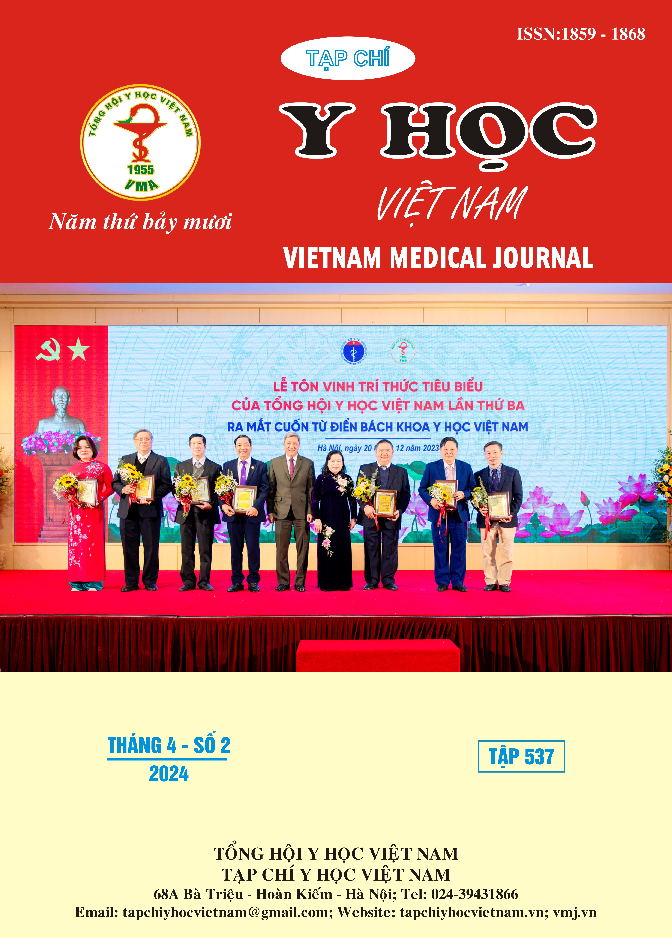INVESTIGATION OF THE RELATIONSHIP BETWEEN KIDNEY STONE DENSITY AND KIDNEY PARENCHYMAL THICKNESS ON MULTI-SLICE COMPUTED TOMOGRAPHY WITH PERCUTANEOUS NEPHROLITHOTRIPSY TIME
Main Article Content
Abstract
Purpose: The aim of this study was to investigate the relationship between kidney stone density and the renal parenchymal thickness on multi-slices computed tomography and percutaneous nephrolithotripsy (PCNL) time. Material and methods: Descriptive study at Hanoi Medical University Hospital from July 2022 to July 2023 on 71 patients with kidney stones who underwent PCNL, had multi-slices CT scan before PCNL and checked the cleanliness of stones after PCNL. Stone density was measured on each stone and the average value was taken for each patient and classified into low density stones <950 Housfield units (UH) and high density stones > 950 UH. The renal parenchymal thickness was classified into ≥18 mm and < 18mm. Then, these values were compared with PCNL time to determine the relationship between these variables and PCNL time, p<0.05 was considered as statistically significant difference. Results: Mean age was 53.8±12.3. The male/female ratio was 1.54. The proportion of stones with density <950 UH (n=9) and >950 UH (n=62) were 12.7% and 87.3%, respectively, corresponding to a PCNL time (in minutes) of 58, 7±28.1 and 68.7±32.8, there was no statistically significant difference (p=0.4) in PCNL time between the two groups of high density stones and low density stones. The proportion of patients with renal parenchymal thickness ≤18 mm (n=32) and >18 mm (n= 39) were 45.1% and 54.9%, respectively. The PCNlithotripsy time (in minutes) of the group with parenchymal thickness ≥ 18mm and <18 mm was 57.18±23.7 and 80±38.12, respectively. There was a statistically significant difference (p=0.005) in PCN lithotripsy time between the two groups with parenchymal thickness ≥18 mm and <18 mm. Conclusion: Our study shows that stone density has no relationship with percutaneous nephrolithotripsy time with p>0.05. On the contrary, kidney parenchymal thickness was related to percutaneous nephrolithotripsy time with p < 0.05. Assessing kidney parenchymal thickness on MSCT played an important role in predicting PCNL results.
Article Details
Keywords
kidney stones density, kidney parenchymal thickness, percutaneous nephrolithotomy, multi-slice computed tomography
References
2. Bùi Văn Lệnh. Chẩn Đoán Hình Ảnh Bộ Máy Tiết Niệu. Nhà xuất bản y học; 2011.
3. Hoàng Long. In: Bài Giảng Bệnh Học Ngoại Khoa. 2013:203-204.
4. Tefekli A, Ali Karadag M, Tepeler K, Sari E, Berberoglu Y, Baykal M, et al. Classification of percutaneous nephrolithotomy complications using the modified Clavien grading system: Looking for a standard. Eur Urol 2008;53:184‐90.
5. de la Rosette JJ, Zuazu JR, Tsakiris P, Elsakka AM, Zudaire JJ, Laguna MP, de Reijke TM. Prognostic factors and percutaneous nephrolithotomy morbidity: A multivariate analysis of a contemporary series using the Clavien classification. J Urol 2008;180:2489‐93.
6. Mishra S, Sabnis RB, Desai M. Staghorn morphometry: A new tool for clinical classification and prediction model for percutaneous nephrolithotomy monotherapy. J Endourol 2012; 26:6‐14.
7. Smith RC, Rosenfield AT, Choe KA, et al. Acute flank pain: comparison of non-contrast-enhanced CT and intravenous urography. Radiology. 1995; 194(3): 789-794. doi: 10.1148/ radiology.194.3.7862980
8. Lai WH, Jou YC, Cheng MC, et al. Tubeless percutaneous nephrolithotomy: Experience of 1000 cases at a single institute. Urological Science. 2017;28(1): 23-26. doi: 10.1016/j.urols. 2016.04.004
9. Liu Y, Chen Y, Liao B, et al. Epidemiology of urolithiasis in Asia. Asian J Urol. 2018;5(4):205-214. doi: 10.1016/j.ajur.2018.08.007
10. Ozgor F, Kucuktopcu O, Sarılar O, et al. Does previous open renal surgery or percutaneous nephrolithotomy affect the outcomes and complications of percutaneous nephrolithotomy. Urolithiasis. 2015; 43(6): 541-547. doi:10.1007/ s00240-015-0798-9.


